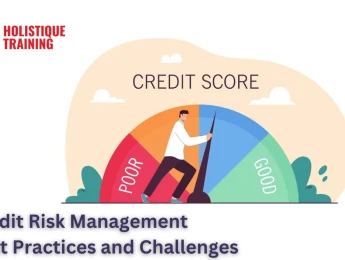- Table of Contents
- Introduction
- What is Credit Risk?
- What is Credit Risk Management?
- Why is Credit Risk Management Important?
- Protecting the Financial Health of Institutions:
- Regulatory Compliance:
- Market Confidence:
- Business Growth and Expansion:
- Avoiding Systemic Risk:
- How to Create a Credit Risk Management Strategy
- 1. Define Risk Appetite
- 2. Develop Risk Assessment Tools
- 3. Set Credit Policies and Limits
- 4. Diversify Credit Portfolios
- 5. Monitor and Review Regularly
- 6. Engage in Continuous Training and Capacity Building
- 7. Implement Automated Risk Management Solutions
- Challenges of Successful Credit Risk Management
- Data Quality and Availability:
- Economic Volatility:
- Technological Integration:
- Regulatory Compliance:
- Emerging Risks:
- Best Practices in Credit Risk Management
- 1. Implement a Risk-Based Pricing Model
- 2. Use Comprehensive Credit Risk Models
- 3. Maintain Strong Data Governance and Analytics
- 4. Establish Clear and Consistent Credit Policies
- 5. Promote Diversification in Lending
- 6. Regularly Monitor Credit Portfolios
- 7. Invest in Technology and Automation
- 8. Ensure Compliance with Regulatory Standards
- Conclusion
Introduction
Credit risk is an essential consideration in the financial landscape, touching upon everything from small business loans to large corporate financing. Companies, banks, and financial institutions must understand the risks involved in lending and how to mitigate them. As global markets evolve and new financial instruments emerge, credit risk management has become more critical than ever before.
This blog post focuses on a detailed examination of credit risk management, from the fundamental understanding of credit risk to the strategies for managing it. We will delve into the intricacies of the five Cs of credit risk, the significance of credit risk management for businesses and financial institutions, the challenges in achieving successful credit risk management, and best practices that help organisations navigate this vital process.
What is Credit Risk?
Credit risk refers to the possibility of a borrower failing to meet their financial obligations to a lender. Whether it's a personal loan, business credit line, or bond issuance, any form of lending carries the potential for non-payment, which constitutes credit risk. This risk can have significant consequences, ranging from loss of revenue to complete financial insolvency for the lender. Understanding credit risk is the first step toward managing it effectively.
The five Cs—character, capacity, capital, collateral, and conditions—are crucial to assessing credit risk and serve as a guideline for lenders to evaluate a borrower’s creditworthiness.
- Character: This element refers to a borrower’s reputation, credit history, and trustworthiness. Lenders assess character by looking at credit scores, past financial behaviour, and references. A strong history of timely payments and responsible credit management suggests that the borrower is more likely to repay the loan, thus representing a lower risk.
- Capacity: Capacity measures the borrower’s ability to repay the loan. Lenders evaluate income, expenses, and existing debts to determine whether the borrower has sufficient cash flow to meet repayment obligations. This is often calculated by examining debt-to-income ratios, financial statements, and employment history.
- Capital: Capital refers to the borrower’s financial commitment or investment in the financed project or asset. For instance, in a business loan, capital could represent the amount of money the business owner has personally invested. Lenders prefer to see borrowers have some skin in the game, as it shows dedication to repaying the loan.
- Collateral: Collateral serves as a form of security for the lender. If the borrower defaults on the loan, the lender can seize the collateral to recover some or all of the funds lent. Collateral can take many forms, including real estate, machinery, or other tangible assets. It reduces the lender’s risk because it provides a backup in case of non-payment.
- Conditions: This refers to the broader economic or industry-specific environment in which the loan is made. Lenders consider market conditions, economic trends, and the borrower’s industry. For example, during an economic downturn, lenders may be more cautious when extending credit due to increased uncertainty about repayment.
The five Cs offer a structured approach to evaluating credit risk, allowing lenders to decide whether to approve or deny a loan. However, even with these tools, predicting borrower behaviour is complex, which is where credit risk management comes into play.
What is Credit Risk Management?
Credit risk management is how financial institutions and businesses identify, measure, and mitigate credit risk to protect themselves against financial loss. Effective credit risk management involves continuous monitoring of credit exposure, ensuring that it aligns with the institution or business's risk appetite. It encompasses all lending stages, from the initial credit assessment to the ongoing management of existing credit portfolios.
The goal of credit risk management is to strike a balance between the risk of lending and the rewards associated with it. By creating robust systems to monitor and mitigate credit risk, businesses and financial institutions can limit their exposure to bad debts and maintain financial stability.
Credit risk management is not just about avoiding risk altogether—it’s about making informed decisions about how much risk an organisation is willing to take. Whether through diversification, setting credit limits, or requiring more stringent terms for higher-risk borrowers, managing credit risk allows organisations to grow while maintaining an acceptable level of risk.
KPI | Description |
Non-Performing Loans Ratio | Percentage of loans not generating income |
Delinquency Rate | Proportion of loans overdue on payments |
Risk-Adjusted Return | Profitability adjusted for credit risk exposure |
Credit Loss Rate | Ratio of credit losses to total loans |
Portfolio Diversification | Measure of spread across different borrowers |
Table 1: Key Performance Indicators (KPIs) of Credit Risk Management
Why is Credit Risk Management Important?
The importance of credit risk management cannot be overstated, especially in a financial landscape that is constantly evolving. Poor credit risk management can lead to significant losses, financial instability, and even bankruptcy for businesses and financial institutions. Here are a few reasons why effective credit risk management is crucial:
Protecting the Financial Health of Institutions:
Credit losses can severely impact an institution's profitability and liquidity. Proper credit risk management helps maintain a healthy balance sheet by preventing excessive exposure to risky borrowers.
Regulatory Compliance:
Regulatory bodies, such as the Basel Committee on Banking Supervision, have set strict guidelines for credit risk management, particularly for banks. Failing to adhere to these regulations can result in hefty fines, legal consequences, and reputational damage.
Market Confidence:
Investors, stakeholders, and customers have more confidence in financial institutions that demonstrate strong credit risk management practices. It shows that the institution is financially stable and capable of managing its risk exposures.
Business Growth and Expansion:
Effective credit risk management allows businesses to lend to a wider range of clients, expanding their market base without taking on excessive risk. With proper risk mitigation strategies, companies can grow without putting their financial health in jeopardy.
Avoiding Systemic Risk:
Credit risk can also have far-reaching consequences across the financial system. For example, the global financial crisis 2008 was largely due to a failure of credit risk management in mortgage lending. Effective risk management prevents such systemic collapses by maintaining discipline in lending practices.
How to Create a Credit Risk Management Strategy
Developing a robust credit risk management strategy is essential for any organisation looking to mitigate the risks associated with lending while optimising returns. A well-structured strategy ensures that an institution is not overly exposed to borrowers who may default while providing a framework for sustained business growth. Below is an elaboration on the steps necessary to create an effective credit risk management strategy:
1. Define Risk Appetite
The foundation of any credit risk management strategy begins with clearly defining the institution'srisk appetite—the level of risk the organisation is willing to accept in pursuit of its financial goals. A risk appetite statement typically outlines acceptable credit risk types and levels, based on an institution's financial strength, business objectives, and market conditions. Defining the risk appetite involves answering questions such as:
- How much exposure to high-risk borrowers is tolerable?
- What loss rates are acceptable within specific credit portfolios?
- How should risks be balanced against potential returns?
Senior management and board members play a crucial role in establishing the risk appetite, ensuring that it aligns with the organisation’s overall business strategy and financial capabilities. Once established, it serves as a guideline for decision-making across the entire lending and credit approval process.
2. Develop Risk Assessment Tools
Credit risk assessment evaluates the likelihood that a borrower will default on their financial obligations. This step is critical in determining whether to extend credit and at what terms. Modern credit risk assessment involves a combination ofqualitative andquantitative tools, including:
- Credit scoring models: These assess the creditworthiness of borrowers based on historical data, credit history, and financial metrics. Personal credit scores like FICO may be used for individual borrowers. For businesses, advanced models assess financial statements, cash flow, and industry risk.
- Predictive analytics and AI: Incorporating machine learning and AI technologies enhances the ability to predict defaults by analysing large datasets in real time. These tools can identify patterns and risk factors that may not be immediately apparent using traditional methods, such as changes in payment behaviours or market volatility.
- Scenario analysis and stress testing: Risk managers simulate different economic or market conditions to see how a borrower’s repayment ability might change. These tests help institutions identify vulnerabilities and adjust their strategies accordingly.
A multi-faceted approach to risk assessment provides a more accurate picture of the borrower’s creditworthiness, enabling better decision-making.
3. Set Credit Policies and Limits
Once the risk appetite and assessment tools are defined, it’s time to develop specificcredit policies that align with these guidelines. Credit policies detail the criteria for granting credit and establish limits for different types of borrowers or transactions. These policies might include:
- Approval processes: Defining who within the organisation can approve certain types of credit and the level of scrutiny required for high-risk loans.
- Credit limits: Establishing maximum exposure levels for different borrower categories, sectors, or geographic regions. For example, an organisation may set a higher credit limit for well-established businesses with strong financials than new startups.
- Collateral requirements: Policies should determine when and how much collateral is required to mitigate potential losses. They should also specify acceptable types of collateral (e.g., property, equipment, securities).
- Loan terms: Outlining standard repayment schedules, interest rates, and penalties for non-compliance. This ensures consistency across loans and reduces the likelihood of unforeseen risks.
By standardising these criteria, organisations ensure that all lending decisions align with the predefined risk appetite and help maintain overall portfolio health.
4. Diversify Credit Portfolios
Diversification is a key pillar of risk management. Rather than concentrating exposure on a single borrower, industry, or region, institutions spread their lending across different categories to reduce overall risk. Adiversified credit portfolio is less vulnerable to systemic shocks, such as an economic downturn in a specific sector or region. Diversification can be achieved through various approaches:
- Industry diversification: Allocating credit across multiple industries minimises the risk of exposure to a sector-specific downturn, such as a collapse in oil prices or a downturn in real estate markets.
- Geographic diversification: Lending to borrowers in different regions or countries reduces the impact of localised economic issues, such as political instability or natural disasters.
- Borrower diversification: Diversifying the types of borrowers (e.g., corporate, small business, personal loans) helps to balance the portfolio and reduce dependency on any one type of borrower.
Proper diversification ensures that potential losses in one area are offset by gains or stability in others, thus creating a more resilient credit portfolio.
5. Monitor and Review Regularly
Continuousmonitoring andreview are crucial components of any credit risk management strategy. Credit risks evolve as market conditions, economic factors, and borrower circumstances change. A proactive approach to risk management involves:
- Regular portfolio reviews: Institutions should frequently assess their credit portfolios to identify emerging risks and problematic loans. This helps prevent small issues from escalating into larger problems.
- Automated monitoring tools: Using technology such as real-timecredit risk dashboards and alerts allows institutions to react swiftly to changes in a borrower’s creditworthiness or market conditions.
- Periodic stress testing: Conducting stress tests helps institutions evaluate how their portfolios would fare under different economic scenarios, such as a sharp recession or interest rate hikes. This helps management adjust policies and limits to ensure they remain within acceptable risk parameters.
A dynamic monitoring system ensures that the institution stays aligned with its risk appetite and can take corrective measures when necessary.
6. Engage in Continuous Training and Capacity Building
Credit risk professionals must stay informed about the latest trends, tools, and regulations in the ever-changing financial landscape. Institutions should continuouslytrain their credit risk teams to ensure they can adapt to new financial products, emerging risks, and evolving regulations.
- Workshops and certifications: Offering employees access to workshops, industry certifications, and courses keeps their skills current and relevant.
- Cross-functional training: Training credit risk professionals in other areas, such as operations or technology, helps them develop a broader understanding of the organisation’s overall risk profile.
By building a knowledgeable and adaptive workforce, institutions are better equipped to navigate the complexities of modern credit risk management.
7. Implement Automated Risk Management Solutions
Automation plays an increasingly vital role in modern credit risk management. Using advanced software systems allows institutions to streamline many manual processes, reducing the likelihood of human error while improving efficiency.Automated risk management solutions help in:
- Credit scoring automation: Automating the process of generating credit scores and assessing borrower risk through AI-driven tools can save time and improve accuracy.
- Ongoing borrower monitoring: Automated systems can continuously track changes in borrower behaviour, flagging early warning signs of default, such as missed payments or a drop in credit score.
- Data analytics integration: By incorporating real-time analytics, institutions can predict changes in borrower risk and adapt lending practices accordingly.
Automation also supports scalability, allowing institutions to handle larger credit portfolios without sacrificing attention to detail.
Crafting an effective credit risk management strategy is a multi-step process that requires careful planning, execution, and ongoing monitoring. By clearly defining risk appetite, utilising advanced risk assessment tools, setting robust credit policies, and leveraging automation, institutions can mitigate credit risk and position themselves for sustainable growth. Furthermore, continuous training and diversification ensure that the strategy remains dynamic, allowing institutions to adapt to new risks and opportunities as they arise.
Challenges of Successful Credit Risk Management
Despite the numerous tools and strategies available, managing credit risk effectively presents several challenges. Institutions must navigate complex market dynamics, regulatory pressures, and technological changes. Here are some common challenges:
Data Quality and Availability:
Credit risk management relies heavily on accurate, up-to-date data. However, obtaining and maintaining high-quality data can take time and effort, particularly for international or small-scale borrowers. Only complete or updated data can lead to correct risk assessments.
Economic Volatility:
Economic downturns, market disruptions, and geopolitical events can all affect borrowers' ability to repay loans. Credit risk management strategies must be flexible enough to adapt to changing economic conditions.
Technological Integration:
Implementing new technologies, such as AI and machine learning, can be both costly and complex. Institutions need to integrate these systems smoothly while ensuring that their human teams can interpret the data and make informed decisions.
Regulatory Compliance:
As governments introduce new regulations to manage systemic risk, institutions must continuously adjust their credit risk management strategies to remain compliant. This requires significant resources and expertise.
Emerging Risks:
New types of credit risk emerge as the financial landscape changes. For example, the rise of peer-to-peer lending and decentralised finance introduces new risks that traditional risk management frameworks may not fully account for.
Metric | Description |
Probability of Default (PD) | Likelihood of borrower defaulting on loans |
Loss Given Default (LGD) | Expected loss if a borrower defaults |
Exposure at Default (EAD) | Total value exposed to borrower default risk |
Credit Value at Risk (CVaR) | Maximum loss over a specific period |
Provision Coverage Ratio | Ratio of provisions to non-performing assets |
Table 2: Metrics Needed to Measure Credit Risk Management
Best Practices in Credit Risk Management
Adoptingbest practices in credit risk management ensures that financial institutions can mitigate potential losses while maximising their profitability and operational efficiency. These practices help maintain a proactive, disciplined approach to assessing and managing credit risk, particularly in today’s fast-evolving economic landscape. Here are the key best practices that should be embedded into any credit risk management framework:
1. Implement a Risk-Based Pricing Model
A fundamental best practice in credit risk management isrisk-based pricing, which ensures that a loan's interest rates and terms reflect the borrower’s creditworthiness and the inherent risk they pose. This practice balances risk and return, allowing institutions to extend credit to a wider range of borrowers without jeopardising profitability.
For instance, high-risk borrowers may receive loans with higher interest rates or stricter repayment terms to offset the potential for default. Conversely, low-risk borrowers can enjoy more favourable terms, incentivising them to choose your institution over competitors. Risk-based pricing protects against loss and aligns with the institution’s risk appetite and business goals.
2. Use Comprehensive Credit Risk Models
Effective credit risk management relies oncomprehensive risk models considering qualitative and quantitative factors. A best practice is implementing sophisticated, multi-dimensional models that go beyond basic credit scores and delve into other aspects of a borrower’s financial health, market behaviour, and historical performance.
- Dynamic risk modelling: Use models that are constantly updated with the latest data to reflect changing market conditions. This could include real-time tracking of borrower performance, fluctuations in market interest rates, and shifts in the borrower’s industry.
- Scenario-based models: These models simulate different economic environments (e.g., recession, inflation spikes) to evaluate how a borrower’s ability to repay loans might change. This foresight helps institutions prepare for adverse conditions by tightening lending policies or adjusting credit limits when necessary.
- Machine learning and AI-driven models: Advanced technologies help risk models analyse large sets of historical and real-time data to predict future risks more accurately than traditional models. AI can also identify subtle patterns in borrower behaviour that human analysts might overlook.
By incorporating a variety of risk models, institutions can have a more granular understanding of a borrower’s creditworthiness, reducing the chances of miscalculated risks.
3. Maintain Strong Data Governance and Analytics
Data quality is a cornerstone of sound credit risk management. Financial institutions must access accurate, reliable, and timely data to make informed lending decisions. As such, investing in strong data governance practices is critical. This involves:
- Centralised data management systems: Creating a centralised repository for all credit-related data, ensuring that it is uniform, up-to-date, and accessible across departments. This prevents data silos and ensures consistency in decision-making.
- Regular data audits: Conducting periodic audits of credit data to ensure its accuracy, reliability, and compliance with regulatory standards. Audits also help to identify any outdated or incomplete data that could impact risk assessments.
- Advanced data analytics: Leveraging tools that enable deep analysis of borrower trends, market conditions, and emerging risks. Advanced analytics, particularly those powered by artificial intelligence and machine learning, can help financial institutions predict potential credit issues early and adjust strategies accordingly.
Robust data governance ensures that decision-makers can rely on high-quality information when assessing credit risk, leading to more precise evaluations and fewer unforeseen risks.
4. Establish Clear and Consistent Credit Policies
Standardised credit policies provide consistency across an institution’s credit evaluation process, helping to mitigate risk while ensuring compliance with regulatory standards. Credit policies should be clear, regularly reviewed, and tailored to different market segments or borrower profiles. Key components of effective credit policies include:
- Loan approval guidelines: Outlining the process for approving credit applications, from initial assessment to final approval, ensures that all loans are subject to the same scrutiny and standards. Different tiers of approval may be required for different types of loans, particularly those that are higher risk.
- Risk classification: Categorising borrowers into different risk categories based on their creditworthiness and assigning appropriate credit terms, such as interest rates or collateral requirements, based on that classification.
- Collateral management: Establishing policies around the types of acceptable collateral, their valuation process, and how they are managed in case of borrower default. Collateral serves as a critical safeguard against credit losses.
By maintaining clear credit policies, institutions can reduce ambiguity in lending practices, promote fairness, and ensure adherence to established risk management frameworks.
5. Promote Diversification in Lending
A key tenet of credit risk management is avoiding overexposure to any single borrower, industry, or geographical area.Diversification spreads risk across various credit portfolios, making it less likely that a single event (e.g., industry downturn, economic recession) will significantly impact the institution. Best practices in diversification include:
- Geographic diversification: Lending to borrowers across different regions or countries reduces exposure to localised economic downturns or regulatory changes that may impact a particular area.
- Industry diversification: Spreading lending across multiple industries ensures that the institution is not overly reliant on one sector. For example, if a financial institution primarily lends to the oil and gas industry, a collapse in oil prices could significantly impact its credit portfolio. By lending across diverse industries, such risks are mitigated.
- Borrower segmentation: Lending to different types of borrowers (e.g., corporate, small business, individual) allows the institution to spread risk across different risk profiles. For instance, a high concentration of loans to large corporations may increase the institution’s vulnerability to corporate defaults, while a mix of business and personal loans reduces this concentration risk.
Diversification ensures that an institution’s overall exposure remains balanced and insulated from sector-specific risks, leading to greater stability.
6. Regularly Monitor Credit Portfolios
Effective credit risk management requiresongoing monitoring of credit portfolios. This is particularly important because borrowers' financial and external economic conditions always evolve. A proactive approach involves:
- Early warning systems: Implement systems that provide alerts when borrowers show signs of financial stress, such as missed payments, declining credit scores, or sudden changes in business operations. This allows institutions to intervene early, potentially restructuring the loan or enforcing tighter controls to reduce exposure.
- Portfolio health checks: Regularly review credit portfolios to assess overall risk levels, identify emerging trends, and ensure the portfolio remains within the institution’s risk appetite. These health checks should be conducted at both macro (industry-wide) and micro (individual borrower) levels.
- Performance benchmarks: Establishing benchmarks for credit portfolios, such as delinquency rates or loss ratios, helps institutions track performance over time. If benchmarks are exceeded, it may indicate that lending policies or risk models need to be adjusted.
Regular monitoring helps to mitigate potential risks before they escalate, ensuring that the institution’s credit portfolio remains resilient in changing environments.
7. Invest in Technology and Automation
Technology is a crucial enabler of modern credit risk management. Institutions that leverage cutting-edge technology are better equipped to assess, monitor, and manage credit risks efficiently. Best practices in adopting technology include:
- Credit risk management software: Investing in software that automates credit assessments, scoring, monitoring, and reporting enhances the efficiency and accuracy of risk management processes. These tools often come with real-time analytics and reporting capabilities, allowing institutions to react quickly to emerging risks.
- Predictive analytics: Predictive models powered by artificial intelligence (AI) and machine learning (ML) help institutions identify potential risks before they materialise. These models can analyse massive datasets to identify patterns and forecast potential borrower defaults with greater accuracy.
- Blockchain and smart contracts: In the future, blockchain technology could streamline credit processes by providing secure, transparent, and immutable transaction records. Smart contracts could automate parts of the lending process, such as loan approvals or collateral management, reducing the risk of fraud or errors.
By investing in technology, institutions can stay ahead of the curve in managing credit risk, ensuring faster, more accurate decision-making while reducing operational costs.
8. Ensure Compliance with Regulatory Standards
Maintaining compliance with regulatory requirements is not just a legal obligation but a best practice that shields institutions from penalties and reputational risks. Credit risk management must account for evolving regulatory frameworks that govern lending practices. This includes:
- Adherence to Basel III: Financial institutions, particularly banks, must comply withBasel III standards, which set minimum capital requirements to protect against credit risks. Basel III emphasises maintaining adequate capital buffers and liquidity ratios to absorb potential losses.
- Local regulations: In addition to international standards, financial institutions must comply with local regulatory requirements concerning credit reporting, consumer protection, and loan recovery practices.
- Anti-money laundering (AML) and Know Your Customer (KYC): Implementing stringentAML andKYC processes ensures that institutions are not lending to or facilitating illegal activities. These processes also protect against reputational damage and regulatory penalties.
Staying compliant ensures the institution avoids legal consequences, protects its reputation, and maintains operational integrity.
Best practices in credit risk management serve as the foundation for a sound and proactive approach to managing lending risks. Financial institutions can effectively mitigate credit risk while maximising profitability by adopting risk-based pricing, using comprehensive credit models, maintaining strong data governance, promoting diversification, and leveraging technology. When executed correctly, these practices help institutions remain resilient in volatile markets and safeguard long-term stability.
Conclusion
Credit risk management is a safeguard against potential financial losses and a strategic component enabling institutions to grow and thrive. By understanding credit risk through the lens of the five Cs, businesses and financial institutions can develop robust credit risk management strategies that protect their interests while fostering growth.
Despite the challenges, adopting best practices, leveraging advanced technology, and maintaining a proactive approach to risk management ensures that organisations can mitigate risks effectively. In an increasingly complex and interconnected financial world, credit risk management is more critical than ever in maintaining the stability and profitability of financial institutions.
Enrol in our Accounting and Finance for Non-Financial Professionals course to further deepen your understanding of key financial concepts like credit risk. This course is designed to equip non-financial professionals with the tools to navigate financial matters, including risk management strategies, confidently. Strengthen your ability to make informed decisions and contribute to your organisation's financial success.

























